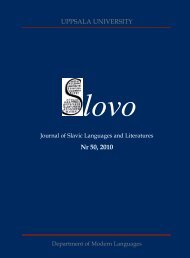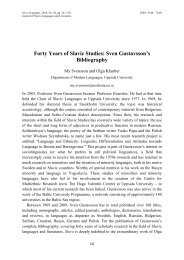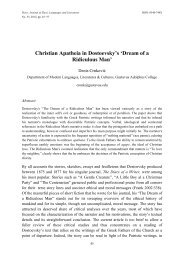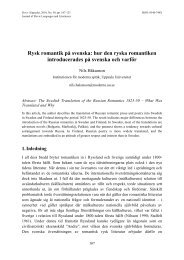UPPSALA UNIVERSITY - Index of - Uppsala universitet
UPPSALA UNIVERSITY - Index of - Uppsala universitet
UPPSALA UNIVERSITY - Index of - Uppsala universitet
- No tags were found...
You also want an ePaper? Increase the reach of your titles
YUMPU automatically turns print PDFs into web optimized ePapers that Google loves.
Daniela AssenovaEditorial: Slovo around the worldAlso clearly noticeable from the statistics is interest in the journal outside Sweden,particularly in Europe and the U.S. (ranked second after Sweden; see Figure 3). Thefive countries with the greatest readership are Sweden (600), USA (124), Bulgaria(74), Russia (54), and Italy (51). Among the top ten countries with the highestreadership, only two have a Slavic language as the national language. One possibleconclusion from this is that the distribution <strong>of</strong> Slovo is still relatively limited in suchcountries, and that we can expect a growth in the number <strong>of</strong> readers when it becomesmore visible there.There is no doubt that statistics give us an impression <strong>of</strong> the quantitative impact <strong>of</strong>the journal’s new electronic format. However, those numbers are not directly related tothe quality <strong>of</strong> Slovo. For this reason another policy change has been introduced thatgoes hand-in-hand with the “globalization” <strong>of</strong> Slovo: all the articles in the current issue<strong>of</strong> Slovo have been peer-reviewed by (at least) two referees, typically a member <strong>of</strong> theadvisory board and an external colleague. We are very grateful for the referees’efforts, since they have contributed significantly to the scholarly quality <strong>of</strong> this new51 st issue.The invited contributor to this issue is Alexander I. Pereswet<strong>of</strong>f-Morath, who isactive as a researcher at the Royal Swedish Academy <strong>of</strong> Letters, History andAntiquities. He is one <strong>of</strong> the leading Scandinavian scholars in the field <strong>of</strong> medievalSlavonic textology, and specializes in Swedish Ingria. His article presents previouslyunknown sources on Isaak Torčakov and discusses the function <strong>of</strong> the “Ingrian church<strong>of</strong>ficials whom seventeenth-century Swedes knew as diaker (d’jački)”.The articles by Thomas Rosén, Nikita Mikhaylov, Christine Watson and KarineÅkerman Sarkisian are based on papers presented by the authors at two conferencesthat took place in Scandinavia during the summer <strong>of</strong> 2010: the Eighteenth NordicSlavists’ Meeting, Tampere, Finland, 18–22 August, and the Eighth Congress <strong>of</strong> theInternational Council for Central and East European Studies, Stockholm, 26–31 July.Common ground for all four <strong>of</strong> these <strong>Uppsala</strong> authors is their specialization indiachronic linguistics and philology. While Rosén, Mikhaylov and Watson presentnew previously unpublished sources, Åkerman Sarkisian presents a proposal for anideal electronic platform for the comparative analysis <strong>of</strong> medieval texts from a userperspective. The digitalization <strong>of</strong> medieval manuscripts is currently a necessity for allscholars whose research is in this field. Per Ambrosiani and Antoaneta Granberg’sarticle presents a national project aimed to describe all Slavic Cyrillic manuscripts andearly printed books in Sweden. The project participants are: Gothenburg, Stockholm,Umeå, and <strong>Uppsala</strong> universities.Juhani Nuorluoto’s article is also connected thematically with historical linguistics:it presents a new theoretical approach to reconstruction <strong>of</strong> the phonologicaldevelopments in Slavic languages, based on a general critical analysis <strong>of</strong> a number <strong>of</strong>sources and their various interpretations.5












